
Register once, drag and drop ECAD models into your CAD tool and speed up your design.
Click here for more information74LVC157ADB-Q100
Quad 2-input multiplexer
the control of a common select input (S). The four outputs present the selected data in the true (non-inverted) form. The enable input (E) is active LOW. When pin E is HIGH, all of the outputs (1Y to 4Y) are forced LOW regardless of all the other input conditions. Moving the data from two groups of registers to four common output buses is a common use of the 74LVC157A. The state of the common data select input (S) determines the particular register from which the data comes. It can also be used as function generator.
It is useful for implementing highly irregular logic by generating any 4 of the 16 different functions of two variables with one variable common.
The device is the logic implementation of a 4-pole, 2-position switch, where the position of the switch is determined by the logic levels applied to pin S.
Inputs can be driven from either 3.3 V or 5 V devices. This feature allows the use of these devices as translators in mixed 3.3 V and 5 V applications
Alternatives
Features and benefits
Automotive product qualification in accordance with AEC-Q100 (Grade 1)
Specified from -40 °C to +85 °C and -40 °C to +125 °C
5 V tolerant inputs for interfacing with 5 V logic
Wide supply voltage range from 1.2 V to 3.6 V
CMOS low power consumption
Direct interface with TTL levels
Complies with JEDEC standard:
-
JESD8-7A (1.65 V to 1.95 V)
JESD8-5A (2.3 V to 2.7 V)
JESD8-C/JESD36 (2.7 V to 3.6 V)
ESD protection:
HBM: ANSI/ESDA/JEDEC JS-001 class 2 exceeds 2000 V
CDM: ANSI/ESDA/JEDEC JS-002 class C3 exceeds 1000 V
DHVQFN package with Side-Wettable Flanks enabling Automatic Optical Inspection (AOI) of solder joints
Parametrics
| Type number | Package name |
|---|---|
| 74LVC157ADB-Q100 | SSOP16 |
Package
All type numbers in the table below are discontinued.
| Type number | Orderable part number, (Ordering code (12NC)) | Status | Marking | Package | Package information | Reflow-/Wave soldering | Packing |
|---|---|---|---|---|---|---|---|
| 74LVC157ADB-Q100 | 74LVC157ADB-Q100J (935301553118) |
Obsolete | VC157A |

SSOP16 (SOT338-1) |
SOT338-1 |
SSOP-TSSOP-VSO-REFLOW
SSOP-TSSOP-VSO-WAVE |
Not available |
Environmental information
All type numbers in the table below are discontinued.
| Type number | Orderable part number | Chemical content | RoHS | RHF-indicator |
|---|---|---|---|---|
| 74LVC157ADB-Q100 | 74LVC157ADB-Q100J | 74LVC157ADB-Q100 |
|
|
Series
Documentation (10)
| File name | Title | Type | Date |
|---|---|---|---|
| 74LVC157A_Q100 | Quad 2-input multiplexer | Data sheet | 2024-02-12 |
| AN11009 | Pin FMEA for LVC family | Application note | 2019-01-09 |
| AN263 | Power considerations when using CMOS and BiCMOS logic devices | Application note | 2023-02-07 |
| lvc157a | lvc157a IBIS model | IBIS model | 2013-04-08 |
| Nexperia_package_poster | Nexperia package poster | Leaflet | 2020-05-15 |
| SSOP16_SOT338-1_mk | plastic, shrink small outline package; 16 leads; 0.65 mm pitch; 6.2 mm x 5.3 mm x 2 mm body | Marcom graphics | 2017-01-28 |
| SOT338-1 | plastic, shrink small outline package; 16 leads; 0.65 mm pitch; 6.2 mm x 5.3 mm x 2 mm body | Package information | 2022-06-20 |
| SSOP-TSSOP-VSO-REFLOW | Footprint for reflow soldering | Reflow soldering | 2009-10-08 |
| lvc | lvc Spice model | SPICE model | 2013-05-07 |
| SSOP-TSSOP-VSO-WAVE | Footprint for wave soldering | Wave soldering | 2009-10-08 |
Support
If you are in need of design/technical support, let us know and fill in the answer form we'll get back to you shortly.
Longevity
The Nexperia Longevity Program is aimed to provide our customers information from time to time about the expected time that our products can be ordered. The NLP is reviewed and updated regularly by our Executive Management Team. View our longevity program here.
How does it work?
The interactive datasheets are based on the Nexperia MOSFET precision electrothermal models. With our interactive datasheets you can simply specify your own conditions interactively. Start by changing the values of the conditions. You can do this by using the sliders in the condition fields. By dragging the sliders you will see how the MOSFET will perform at the new conditions set.
